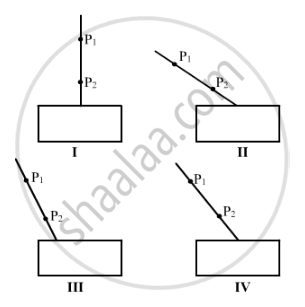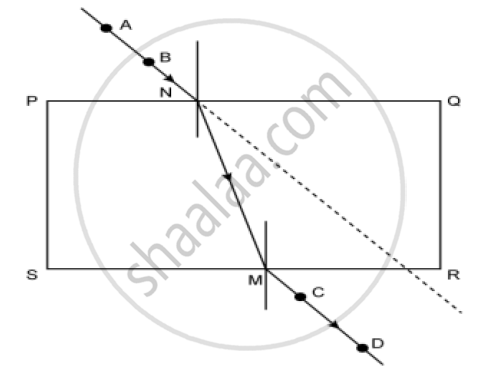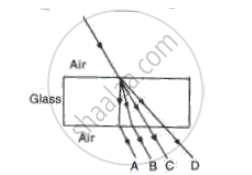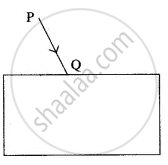Advertisements
Advertisements
Question
Why do we get a spectrum of seven colors when white light is dispersed by a prism?
Solution
The refractive index of the material of the prism is different for different colours. White light is composed of seven colours. When white light is incident on a prism, the constituent colours get refracted through different angles and get dispersed. So, the rays of each colour emerge along different paths and become distinct. Hence, we get a spectrum of seven different colours.
APPEARS IN
RELATED QUESTIONS
Explain how spectrum is formed.
Choose the correct alternative and rewrite the following sentence.
A ray of light strikes the glass slab at an angle of 50°. What is the angle of incidence?
Study the following four experimental set-ups I, II, III and IV for the experiment, "To trace the path of a ray of light through a rectangular glass slab."

Which of the marked set-ups is likely to give best results (P1 and P2 are the positions of pins fixed on the incident ray)?
(A) I
(B) II
(C) III
(D) IV
Explain the term absolute refractive index of a medium and write an expression to relate it with the speed of light in vacuum.
Name one factor that affects the lateral displacement of light as it passes through a rectangular glass slab.
A ray of light passes from water to air. How does the speed of light change?
The following diagram shows a 60°, 30°, 90° glass prism of critical angle 42°, Copy the diagram and complete the path of incident ray AB emerging out of the prism marking the angle of incidence on each surface.

Observe the following figure and answer the questions given under it:

1) How many times does refraction take place in the above figure?
2) What happens to the ray of light when it passes from air to glass?
3) What happens to the ray of light when it passes from glass to air?
4) What are the rays AB and CD in the figure called?
5) Define refraction.
How can you bend light away from the normal?
How must light travel out of a substance if it is not going to be refracted?
Fill in the blanks to complete the following sentence
When light travels from a denser to a rarer medium, its speed ……………….
A Water pond appears to be 2.7 m deep. If the refractive index of water is 4/3, find the actual depth of the pond.
Select from the following the best experimental set-up for tracing the path of a ray of light through a glass slab: (A) I
(A) I
(B) II
(C) III
(D) IV
-
- the angle of refraction and
- the angle of deviation for the ray?
In the fig. name the ray which represents the correct path of light while passing through a glass block.

Draw a diagram to show the splitting of white light into its constituent colours.
Why does a fisherman aim at the tail of fish during spearfishing?
Why upper surface of water contained in a beaker and above eye level appears silvery?
A ray of light passes from water to air. How does the speed of light change?
Write a relation between the angle of incidence (i), angle of emergence (e), angle of the prism (A), and angle of deviation (d) for a ray of light passing through an equilateral prism.
What is the refractive index of vacuum
Explain briefly what causes the twinkling of stars at night.
The refractive index of air with respect to glass is defined: as gµa = sin i/sin r
Write down a similar expression for aµg in terms of angle i and r.
In the diagram below, PQ is a ray of light incident on a rectangular glass block.

Copy the diagram and complete the path of the ray of light through the glass block. In your diagram, mark the angle of incidence by letter ‘i’ and the angle of emergence by the letter ‘e’.
Draw ray of light bending towards the normal while passing from air to glass. Label your diagrams.
Draw a diagram to show the refraction of a monochromatic light ray through an equilateral prism. On the diagram, label the incident, refracted, and emergent rays. It also indicates the angle of deviation by the letter δ.
The diagram shows the path of a ray of light through a rectangular glass block placed in a liquid of uniform density.

(a) Does the light speed up or slow down in the glass,
(b) Give the reason for your answer.
The diagram shows the path of a ray of light through a rectangular glass block placed in a liquid of uniform density.

Show with the help of a ray diagram the path of the ray when incident ray normally falls on the first surface of the glass block and passes through the block and the liquid.
Draw a diagram of a prism and label:
(i) the base,
(ii) the refracting surfaces,
(iii) the refracting edge,
(iv) the refracting angle in it.
The speed of light in air is 3 × 108 ms-1. Calculate the speed of light in water. The refractive index of water is 4/3.
Write the approximate values of speed of light in (i) air and (ii) glass. Use these values to calculate the refractive index of glass with respect to air.
The refractive index of glass with respect to air is 1.5. What is the value of the refractive index of air with respect to glass?
A ray of light is incident at an angle of 45° on one face of a rectangular glass slab of thickness 10 cm and refractive index 3/2. Calculate the lateral shift produced ______.
Which colour of white light travels fastest in any medium except air?
A ray of light strikes the surface of a rectangular glass slab such that the angle of incidence in air is
- 0°,
- 45°.
In each case, draw a diagram to show the path taken by the ray as it passes through the glass slab and emerges from it.
